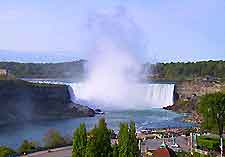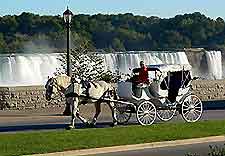Niagara Falls Weather, When to Go and Climate Information
(Niagara Falls, Ontario - ON, Canada)

Niagara Falls stands along Northern California's latitude line, close to North America, and offers favorable weather and a pleasant climate. With much milder winters than many other cities in Canada, Niagara Falls features plenty of sunny weather and fine days, particularly during the summer months, although the weather at this time of the year in Niagara Falls can be a little unpredictable and damp at times.
Many of the attractions around the Falls of Niagara are affected by the mists, which make the climate and temperatures appear cooler. The city center is a particularly warm part of Niagara Falls and the fine, clear weather allows spectacular views from the numerous high-rise buildings in and around Clifton Hill.
Spring
The weather is Niagara Falls begins to noticeably warm up in March, when the daytime temperatures remain well above freezing, reaching over 5°C / 41°F on most days. By the time April arrives, summer is just around the corner and many of the flowers and trees emerge from their winter dormancy due to the mild spring weather. Towards the end of April, average spring temperatures in Niagara Falls peak at 15°C / 59°F, or on occasion, even higher, although some breezy days may still feel chilly.

Summer
When summer weather arrives in Niagara Falls, the city hosts many of its most popular outdoor festivals and recreational activities, in and around the parklands. The weather and climate in Niagara Falls is hottest between June and August, with temperatures often reaching in excess of 30°C / 86°F during the month of July. However, heavy rain showers during the summer months are by no means uncommon and can result in a rapid fall in the temperature, although rainy weather is often short lived.
Autumn / Fall
The autumn weather and climate in Niagara Falls is surprisingly mild for a Canadian city, being affected greatly by its close proximity to the North American border and its location between Lake Ontario to the north, and Lake Erie to the south. Even in late October, the average daytime temperatures in Niagara Falls remain well above 10°C / 50°F, although the nights begin to feel much colder.
Winter
Winter weather in Niagara Falls is coldest between December and March, when heavy overnight frosts regularly occur. In December, daytime temperatures generally remain above freezing, although in January they average around -1°C / 30°F. Snowy weather is frequent during the winter months and the Niagara River becomes partially frozen, preventing the popular boat tours of the Falls.
Niagara Falls Weather and Climate Chart (Averages)
| |
Maximum |
Minimum |
January |
-1°C / 30°F |
-8°C / 18°F |
February |
0°C / 32°F |
-7°C / 19°F |
March |
5°C / 41°F |
-3°C / 27°F |
April |
12°C / 54°F |
2°C / 36°F |
May |
19°C / 66°F |
8°C / 46°F |
June |
24°C / 75°F |
14°C / 57°F |
July |
27°C / 81°F |
16°C / 61°F |
August |
25°C / 77°F |
15°C / 59°F |
September |
22°C / 72°F |
12°C / 54°F |
October |
15°C / 59°F |
6°C / 43°F |
November |
8°C / 46°F |
1°C / 34°F |
December |
2°C / 36°F |
-5°C / 23°F |
 Niagara Falls stands along Northern California's latitude line, close to North America, and offers favorable weather and a pleasant climate. With much milder winters than many other cities in Canada, Niagara Falls features plenty of sunny weather and fine days, particularly during the summer months, although the weather at this time of the year in Niagara Falls can be a little unpredictable and damp at times.
Niagara Falls stands along Northern California's latitude line, close to North America, and offers favorable weather and a pleasant climate. With much milder winters than many other cities in Canada, Niagara Falls features plenty of sunny weather and fine days, particularly during the summer months, although the weather at this time of the year in Niagara Falls can be a little unpredictable and damp at times.